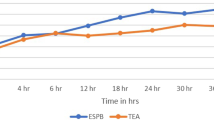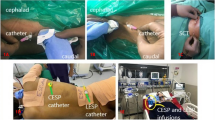Abstract
Objective
Rib fractures represent a significant cause of morbidity and mortality in trauma patients. The erector spinae plane block has come to the forefront as a potential safe and effective option for analgesia in painful conditions of the thorax over multiple dermatomal levels. Given the high morbidity associated with rib fractures, the inadequacy of opioid analgesia and the strong safety profile of the erector spinae plane block, this pilot study sought to address whether this block can be used to safely and effectively provide analgesia in emergency department (ED) patients with acute rib fractures.
Methods
A total of nine patients underwent the procedure successfully. Patients were found to have a significant reduction in their pain score pre- and post-block. The reduction in mean pre- and post-block pain scores was 9.89 vs 3.56 which was statistically significant (p < 0.0001).
Conclusion
In a pilot sampling of emergency department patients with acute fractures who failed traditional analgesic therapy, the erector spinae plane block performed by emergency physicians provided safe and effective pain control. Further research is needed to fully establish the clinical benefit and safety of this procedure.
Résumé
Objectifs
Les fractures des côtes représentent une cause importante de morbidité et de mortalité chez les patients traumatisés. Le bloc du plan des muscles érecteurs du rachis est apparu comme une option potentiellement sûre et efficace pour l’analgésie dans les états douloureux du thorax sur plusieurs niveaux dermatomiques. Compte tenu de la morbidité élevée associée aux fractures des côtes, de l’insuffisance de l’analgésie opiacée et du profil d’innocuité solide d'un bloc du plan des muscles érecteurs du rachis, cette étude pilote visait à déterminer si ce bloc peut être utilisé pour fournir une analgésie sûre et efficace aux patients des urgences présentant des fractures aiguës des côtes.
Méthodes
Au total, neuf patients ont subi l’intervention avec succès. On a constaté que les patients avaient une réduction significative de leur score de douleur avant et après le blocage. La réduction des scores moyens de la douleur avant et après le blocage était de 9.89 contre 3.56, ce qui était statistiquement significatif (p < 0.0001).
Conclusion
Dans le cadre d’un projet pilote d’échantillonnage de patients des services d’urgence ayant subi des fractures aiguës et ayant échoué à la thérapie analgésique traditionnelle, le bloc du plan des muscles érecteurs du rachis effectué par les médecins urgentistes a permis de contrôler efficacement et en toute sécurité la douleur. Des recherches supplémentaires sont nécessaires pour établir pleinement les avantages cliniques et la sécurité de cette procédure.

Similar content being viewed by others
References
Pressley C, Fry W, Philp A, Berry S, Smith R. Predicting outcome of patients with chest wall injury. Am J Surg. 2012;204(6):910–4.
Duch P, Møller MH. Epidural analgesia in patients with traumatic rib fractures: a systematic review of randomised controlled trials. Acta Anaesthesiol Scand. 2015;59(6):698–709. https://doi.org/10.1111/aas.12475.
Galvagno SM Jr, Smith CE, Varon AJ, Hasenboehler EA, Sultan S, Shaefer G, To KB, Fox AD, Alley DE, Ditillo M, Joseph BA, Robinson BR, Haut ER. Pain management for blunt thoracic trauma: a joint practice management guideline from the Eastern Association for the surgery of trauma and trauma anesthesiology society. J Trauma Acute Care Surg. 2016;81(5):936–51. https://doi.org/10.1097/TA.0000000000001209.
Forero M, Adhikary S, Lopez H, Tsui C, Chin K. The erector spinae plane block. Reg Anesth Pain Med. 2016;41(5):621–7.
Ivanusic J, Konishi Y, Barrington M. A cadaveric study investigating the mechanism of action of erector spinae blockade. Reg Anesth Pain Med. 2018;43(6):567–71.
Kotteeswaran Y, Manoo V, McLaren-Blades A, Kahn M, Huang A, et al. A series of erector spinae plane blocks reduced pain and opioid consumption in patients with post herpetic neuralgia: two patient cases. Int J Anesth Anesthesiol. 2020;7(3):109. https://doi.org/10.23937/2377-4630/1410109.
Jadon A, Jain P, Sinha N. The erector spinae plane block for postoperative analgesia in abdominoplasty—a case report. Bio-accent Open Journal Anesthesia. Available from https://www.researchgate.net/publication/314238589. 2017;1: 001.
Bijur P, Latimer C, Gallagher E. Validation of a verbally administered numerical rating scale of acute pain for use in the emergency department. Acad Emerg Med. 2003;10(4):390–2. https://doi.org/10.1111/j.1553-2712.2003.tb01355.x.
Adhikary S, Bernard S, Lopez H, Chin K. Erector spinae plane block versus retrolaminar block: a magnetic resonance imaging and anatomical study. Reg Anesth Pain Med. 2018;43(6):00–00.
American Society of Anesthesiologists [Internet]. Committee on Standards and Practice Parameters (CSPP). Standards for basic anaesthetic monitoring. Available from: https://www.asahq.org/standards-and-guidelines/standards-for-basic-anesthetic-monitoring. Accessed on 13 Dec 2020.
Luftig J, Mantuani D, Herring A, Dixon B, Clattenburg E, Nagdev A. Successful emergency pain control for posterior rib fractures with ultrasound-guided erector spinae plane block. Am J Emerg Med. 2017. https://doi.org/10.1016/j.ajem.2017.12.060.
Kumar G, Bhoi SK, Sinha TP, Paul S. Erector spinae plane block for multiple rib fracture done by an emergency physician: a case series. Aust J Ultrasound Med. 2020;24(1):58–62. https://doi.org/10.1002/ajum.12225.
Tekşen S, Öksüz G, Öksüz H, Sayan M, Arslan M, Urfalıoğlu A, Gişi G, Bilal B. Analgesic efficacy of the serratus anterior plane block in rib fractures pain: a randomized controlled trial. Am J Emerg Med. 2021;4:16–20. https://doi.org/10.1016/j.ajem.2020.12.041.
Beard L, Hillermann C, Beard E, Millerchip S, Sachdeva R, Gao Smith F, Veenith T. Multicenter longitudinal cross-sectional study comparing effectiveness of serratus anterior plane, paravertebral and thoracic epidural for the analgesia of multiple rib fractures. Reg Anesth Pain Med. 2020;45(5):351–6. https://doi.org/10.1136/rapm-2019-101119 (Epub 2020 Mar 11 PMID: 32165553).
Author information
Authors and Affiliations
Corresponding author
Ethics declarations
Conflict of interest
The study authors have no conflicts of interest to disclose.
Supplementary Information
Below is the link to the electronic supplementary material.
Supplementary file3 (MP4 29025 KB)
Rights and permissions
About this article
Cite this article
Surdhar, I., Jelic, T. The erector spinae plane block for acute pain management in emergency department patients with rib fractures. Can J Emerg Med 24, 50–54 (2022). https://doi.org/10.1007/s43678-021-00203-x
Received:
Accepted:
Published:
Issue Date:
DOI: https://doi.org/10.1007/s43678-021-00203-x




